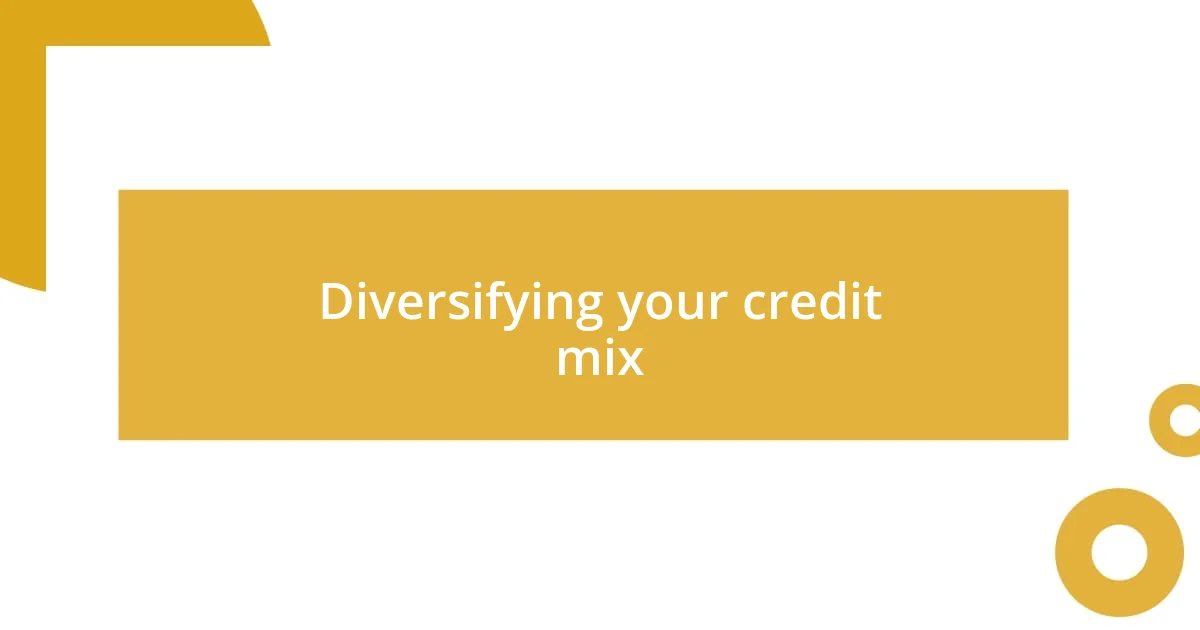Key takeaways:
- A good credit score is crucial for financial opportunities like lower interest rates and improved insurance premiums, highlighting the importance of responsible debt management.
- Using secured cards effectively boosts credit scores through timely payments, low utilization, and the potential transition to unsecured cards, fostering financial responsibility.
- Diversifying credit types, such as adding loans to a credit profile, enhances creditworthiness by showcasing the ability to manage different debt types, promoting overall financial growth.

Understanding credit scores importance
Understanding the importance of credit scores truly changed my journey towards financial stability. When I first started managing my finances, I often wondered, “Why does my credit score even matter?” It was only when I faced the harsh reality of loan rejections that I truly grasped its impact.
A good credit score opens up opportunities that can feel out of reach. It can mean lower interest rates on loans, better credit card offers, and even more affordable insurance premiums. I remember the moment I received an approval for my first car loan; the feeling of relief and accomplishment was unmatched, and it reminded me of how a strong credit score can steer your financial future in a positive direction.
Understanding credit scores goes beyond numbers—it reflects how responsibly we manage our debts. Every missed payment can feel like a weight dragging us down, but with awareness and action, we can lift ourselves up. Have you thought about what your credit score says about you? I’ve learned that by simply keeping track of it, I empower myself to make informed financial decisions that support my long-term growth.

Building credit with secured cards
Secured cards were a game-changer for me when I was starting to build my credit. I was hesitant at first, thinking they might seem like a “second-best” option, but I quickly realized how effective they could be. By providing a cash deposit as collateral, these cards helped me take control of my credit path. I vividly remember the day my secured card arrived in the mail; I felt a spark of hope. I knew this was my chance to establish a solid credit history.
To effectively build credit with secured cards, consider these key points:
– Choose the right card: Look for secured cards that report to all three credit bureaus (TransUnion, Equifax, and Experian).
– Make timely payments: Always pay your balance on time; this habit positively influences your credit score.
– Keep utilization low: Aim to use less than 30% of your credit limit to show responsible usage.
– Gradually increase your limit: Some issuers allow you to increase your deposit over time, further boosting your credit potential.
– Transition to an unsecured card: Once you’ve built a positive credit history, many secured cards offer an upgrade option, helping you continue to grow your credit without the collateral.
In my experience, using a secured card not only improved my credit score but instilled a sense of financial responsibility in me. It felt empowering to take that first step towards my financial goals, and I believe anyone can replicate that success with the right approach.

Paying bills on time consistently
Paying bills on time has perhaps been the cornerstone of my journey toward a solid credit score. I still remember the days when I would anxiously check my calendar, ensuring I didn’t miss a due date. That sense of responsibility transformed my financial health and gave me peace of mind. I learned that every on-time payment is a building block in the foundation of my credit, and that consistency truly pays off. It’s like watering a plant—you need to do it regularly to see it grow.
In my experience, I found that setting reminders on my phone was a game-changer. I even established a routine that involved paying my bills as soon as they arrived. That way, I could avoid the stress of last-minute payments and ensure I was always ahead of the game. Sometimes, I treat it like a mini celebration—every time I hit “send” on a payment, I remind myself how much I’m investing in my future. By prioritizing timely payments, I was not just improving my credit score but also cultivating healthier financial habits overall.
Looking back, it’s astonishing how that small change made a big difference in my life. It wasn’t just about avoiding late fees; it was all about taking control. I felt empowered knowing that my financial future depended on my actions. Have you tried setting up automatic payments? I often recommend this strategy because it can safeguard against missed deadlines—trust me, it simplifies the process and keeps your score looking healthy.
| Impact of Timely Payments | Consequences of Late Payments |
|---|---|
| Improves credit score | Decreases credit score |
| Builds trust with lenders | Can lead to higher interest rates |
| Prevents late fees | Can result in penalties or service interruptions |

Managing credit utilization ratio
Managing your credit utilization ratio has been one of the most pivotal elements in my credit-building journey. I discovered early on that this ratio, which measures the amount of credit you’re using compared to your total credit limit, plays a significant role in influencing your credit score. I can still recall the moment I realized my utilization was too high; my heart sank when I saw how it impacted my score. Staying below 30% of my credit limit felt like a challenge at first, but it encouraged me to be more mindful of my spending.
I started to track my credit card spending closely, which was quite eye-opening. Each month, I set a specific budget for myself and aimed to use only a fraction of my available credit. When I kept my utilization low, it felt gratifying—almost like a game where every time I paid off my balance, I scored points towards a better credit standing. Have you ever taken an analytical approach to your own spending? It can transform how you perceive your resources and help you make smarter choices.
To make managing my utilization even easier, I opted for multiple credit cards but spread out my expenses across them. This strategy not only kept my ratio down but also allowed me to build relationships with various lenders. I remember the thrill of watching my score gradually improve, and the moment I saw my utilization dip below 10%—it felt like I had unlocked a new level of financial wellness. Each point gain reminded me of how important it is to keep a close eye on this ratio, ensuring that I’m not just building my credit but cultivating a responsible financial lifestyle.

Diversifying your credit mix
As I dove into the world of credit, diversifying my credit mix became an unexpected yet crucial step in my journey. Initially, I only had a couple of credit cards, but I learned that adding different types of credit—like an auto loan or a small personal loan—could significantly enhance my credit profile. It felt a bit nerve-wracking to take on new types of debt, but then I realized that it was about building a more robust credit history that lenders would recognize and appreciate. Have you considered how diversifying your credit can impact your score?
Gradually introducing new credit accounts allowed me to demonstrate my ability to manage various types of debt. I remember the first time I got a small personal loan; I was hesitant but also excited. Within a few months, I could see how the combination of revolving credit from my cards and installment credit from the loan had positively influenced my credit score. Each type of credit contributed to a more comprehensive picture of my creditworthiness. It was like adding new colors to a canvas and seeing my financial portrait come together beautifully.
I can’t stress enough how this strategy has broadened my understanding of credit. It’s not just about having a single credit card; it’s about showcasing your financial adaptability. Mixing things up not only promotes a better score but also gives you the confidence to navigate different financial situations. Have you taken the plunge into diversifying your own mix? I found that the value of diversifying my credit mix extends beyond numbers; it represents my growth as a responsible borrower.














